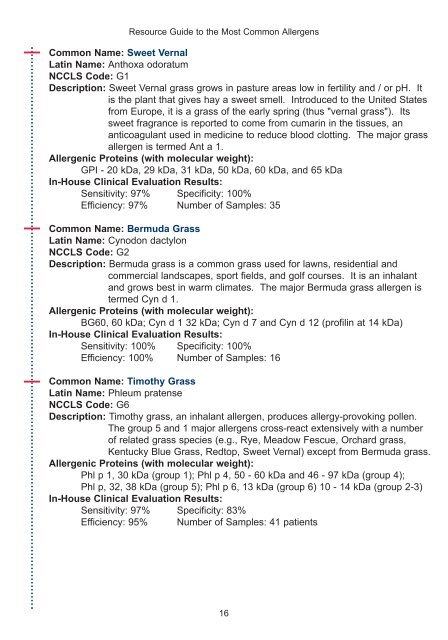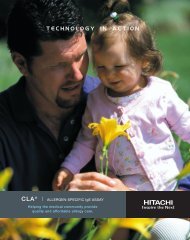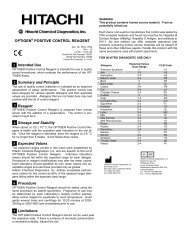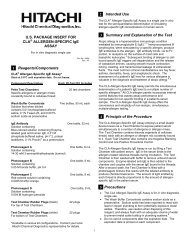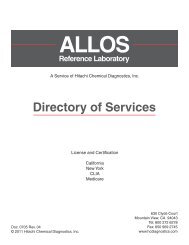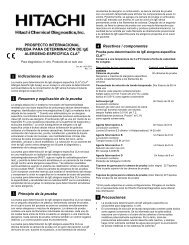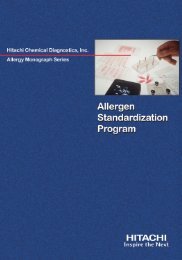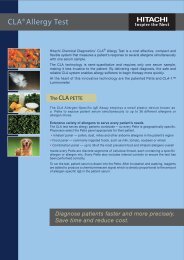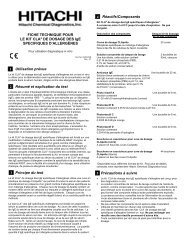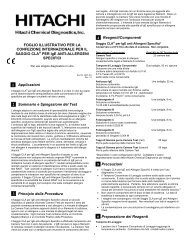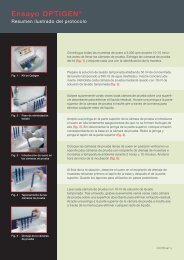Allergen Resource Guide - Hitachi Chemical Diagnostics
Allergen Resource Guide - Hitachi Chemical Diagnostics
Allergen Resource Guide - Hitachi Chemical Diagnostics
You also want an ePaper? Increase the reach of your titles
YUMPU automatically turns print PDFs into web optimized ePapers that Google loves.
<strong>Resource</strong> <strong>Guide</strong> to the Most Common <strong>Allergen</strong>s<br />
Common Name: Sweet Vernal<br />
Latin Name: Anthoxa odoratum<br />
NCCLS Code: G1<br />
Description: Sweet Vernal grass grows in pasture areas low in fertility and / or pH. It<br />
is the plant that gives hay a sweet smell. Introduced to the United States<br />
from Europe, it is a grass of the early spring (thus "vernal grass"). Its<br />
sweet fragrance is reported to come from cumarin in the tissues, an<br />
anticoagulant used in medicine to reduce blood clotting. The major grass<br />
allergen is termed Ant a 1.<br />
<strong>Allergen</strong>ic Proteins (with molecular weight):<br />
GPI - 20 kDa, 29 kDa, 31 kDa, 50 kDa, 60 kDa, and 65 kDa<br />
In-House Clinical Evaluation Results:<br />
Sensitivity: 97% Specificity: 100%<br />
Efficiency: 97% Number of Samples: 35<br />
Common Name: Bermuda Grass<br />
Latin Name: Cynodon dactylon<br />
NCCLS Code: G2<br />
Description: Bermuda grass is a common grass used for lawns, residential and<br />
commercial landscapes, sport fields, and golf courses. It is an inhalant<br />
and grows best in warm climates. The major Bermuda grass allergen is<br />
termed Cyn d 1.<br />
<strong>Allergen</strong>ic Proteins (with molecular weight):<br />
BG60, 60 kDa; Cyn d 1 32 kDa; Cyn d 7 and Cyn d 12 (profilin at 14 kDa)<br />
In-House Clinical Evaluation Results:<br />
Sensitivity: 100% Specificity: 100%<br />
Efficiency: 100% Number of Samples: 16<br />
Common Name: Timothy Grass<br />
Latin Name: Phleum pratense<br />
NCCLS Code: G6<br />
Description: Timothy grass, an inhalant allergen, produces allergy-provoking pollen.<br />
The group 5 and 1 major allergens cross-react extensively with a number<br />
of related grass species (e.g., Rye, Meadow Fescue, Orchard grass,<br />
Kentucky Blue Grass, Redtop, Sweet Vernal) except from Bermuda grass.<br />
<strong>Allergen</strong>ic Proteins (with molecular weight):<br />
Phl p 1, 30 kDa (group 1); Phl p 4, 50 - 60 kDa and 46 - 97 kDa (group 4);<br />
Phl p, 32, 38 kDa (group 5); Phl p 6, 13 kDa (group 6) 10 - 14 kDa (group 2-3)<br />
In-House Clinical Evaluation Results:<br />
Sensitivity: 97% Specificity: 83%<br />
Efficiency: 95% Number of Samples: 41 patients<br />
16


